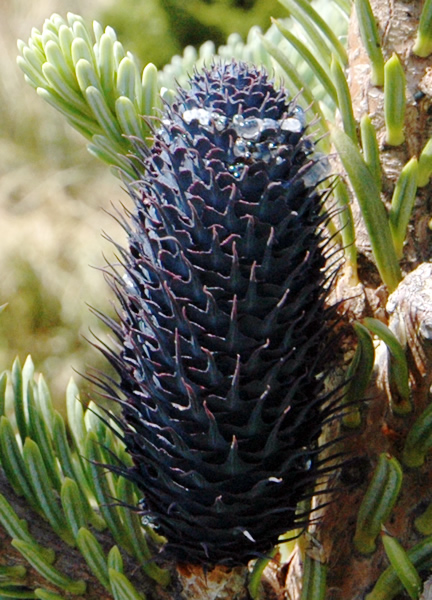| General Description | Abies squamata 'Flaky’ is a tall, very unique tree largely due to its purple cones and flaky-like bark. |
| ID Characteristic | Abies squamata ‘Flaky’ has outstanding purple upright cones and flake-like reddish-brown exfoliating bark which make this a unique evergreen tree that can be identified quite easily. |
| Shape | Loose form with an upright growth habit. |
| Landscape | Not primarily used in the landscape due to rarity, but may be used as a lawn ornament. |
| Cultivation | Prefers well drained or dry acidic soils and can withstand living in light (sandy) soil, medium (loamy) soil and heavy (clay) soil. This species can tolerate full/some shade and full/some sun, although if subject to full shade when young the tree will grow much slower. It is pollinated by wind. |
| Pests | No known pest/disease for this particular cultivar. Note the Abies genus is subject to spruce budworm. |
| Notable Specimens | Whistling Gardens, Wilsonville, Ontario, Canada. |
| Habitat | Horticultural origin. |
| Bark/Stem Description | Rich, brown-reddish, thin, papery, exfoliating bark (similar to birch) which allows for winter interest. |
| Flower/Leaf Bud Description | Cones are oblong, ovate to 5 – 6 cm long, violet colour when young. Tips have bract overhanging the seed scales and are 1.5 cm long, globose, red-brown and very resinous. |
| Leaf Description | Needles are densely arranged, linear, 1.5 – 2.5 cm long, rounded tip, with 2 white stomata bands on lower part of tree and a distinct vein up the back of the needle. |
| Flower Description | Flowers are monecious, individual flowers, male or female; but can find both sexes on a plant; pollinated by wind. |
| Colour Description | Needles are dark blue-green with silvery undersides. Cones are violet colour when young and a striking purple colour when mature. |
| Texture Description | Leathery, stiff needles. |
